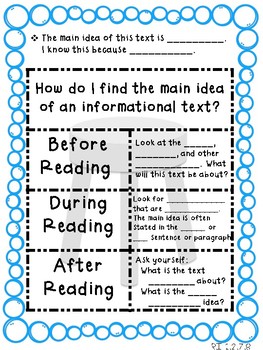patenting an invention: What is necessary for a patent to be granted? Patenting an invention is a process that can be used to protect a person’s intellectual property. The patent office will look at the invention and whether it is possible to make it widely available. The application must also include details about the inventor, their product, and what the patent covers. If all of these requirements are met, the patent can be granted.
looking for Main idea anchor chart 5th grade | Anchor Charts | Pinterest | Anchor you’ve came to the right page. We have 9 Images about Main idea anchor chart 5th grade | Anchor Charts | Pinterest | Anchor like Main Idea and Main Topic Anchor Chart Ideas - Elementary Nest, Main idea anchor chart 5th grade | Anchor Charts | Pinterest | Anchor and also Main Idea Anchor Chart First Grade - IdeaWalls. Read more:
Main Idea Anchor Chart 5th Grade | Anchor Charts | Pinterest | Anchor

Source: pinterest.com
.
- A new way to monitor health care treatments
5th Grade Tomfoolery | Historical Fiction Writing, Historical Fiction

Source: pinterest.com
fiction historical anchor grade charts chart reading 5th writing elements teaching genre narrative strategies books tomfoolery 6th third stars student.
The word innovation has been bandied about for centuries, but what exactly is it? Economist John Kenneth Galbraith defined innovation as “the process of making something new and useful.” And that can be applied to everything from the smallest things to the largest projects. In business, innovation is everything from slashing costs to coming up with new ways to market a product or service.
Teaching About Themes… Using The Cupcake Analogy! | Reading Anchor

Source: pinterest.com
theme themes anchor teaching literature chart reading cupcake analogy connections crafting charts identify strategies posters skills comprehension students.
The different types of ideas: brainstorming,Idea Bank,Noodle Jar,Prototypes brainstorming, ideabank,noodle jar,prototypes
Anchor Chart For Teaching Main Idea By First In Line | TpT

Source: teacherspayteachers.com
anchor idea chart main teaching subject grade.
- Make a homemade lamp: A lamp is a basic piece of furniture, and nothing says homecoming like a homemade one.
Topic Vs. Theme Anchor Chart #englishlanguagearts #reading

Source: pinterest.com
anchor theme topic chart vs charts reading grade themes activities strategies anchorcharts comprehension teaching.
Processes that lead to innovation: Innovation is a result of many factors, but one of the most important is process. Processes that lead to innovation are essential for creating new ideas and products. By understanding these processes, businesses can create innovative products and processes that will help them grow and succeed.
Main Idea And Main Topic Anchor Chart Ideas - Elementary Nest

Source: elementarynest.com
.
How to Take advantage of Social Media to Grow Your Blog There are a few things you can do to take advantage of social media to help your blog grow. You can use it as a platform to share your content, connect with potential customers, and promote your business. Additionally, using social media can be a great way to build relationships with other bloggers and create networking opportunities. Whether you’re new to social media or have been using it for years, there are a few things you needto keep in mind if you want to maximize its potential for growth.
3rd Grade | Main Idea Anchor Chart, Anchor Charts, Main Idea

Source: pinterest.com
.
The future of technology As technology continues to evolve, we can expect to see a more interconnected world. This could lead to new opportunities for businesses and individuals, as well as new challenges. Some of the key Ideas for the future of technology include:
- Virtual Reality: With advancements in VR technology, users will be able to explore new worlds and engage in exciting experiences that were previously impossible. This could have a huge impact on industries such as entertainment, education, and health care.
- Nano-Technology: nano-tech is becoming increasingly used in various fields such as healthcare and transportation. By making small changes to materials, nano-tech can improve efficiency and reduce costs. This could have a significant impact on the economy and society as a whole.
- Blockchain Technology: blockchain technology is an innovative way of handling transactions that was created by Satoshi Nakamoto.
Main Idea Anchor Chart First Grade - IdeaWalls
Source: ideawalls.blogspot.com
.
Ideas are a necessary part of any creative process. By taking some time to come up with interesting and new ideas, you can help keep your mind active and ferment new thoughts. When it comes to creativity, it’s important to be open to new ideas and not be afraid to experiment.
The Three Branches Of Government- 3rd Grade … | Social Studies

Source: pinterest.com
branches government studies social three grade 3rd anchor projects teaching chart essay charts elementary activities 5th constitution local conclusion state.
The telephone: How it was invented and how it has changed In 1876, Alexander Graham Bell was born in Edinburgh, Scotland. Inventor of the telephone, his most famous invention transformed communication forever. The first words spoken by Bell over his invention were “Mr. Watson–come here–I want to see you.” Just one year after the birth of Bell, the first practical telephone was invented by Philipp Reis of Germany. His device could transmit sounds but not intelligible speech.
Bell continued work on Reis’s design and eventually created an improved version that could transmit speech. On March 10, 1876, Bell made the first successful call between two buildings in Boston. The following month, he received a patent for his invention.